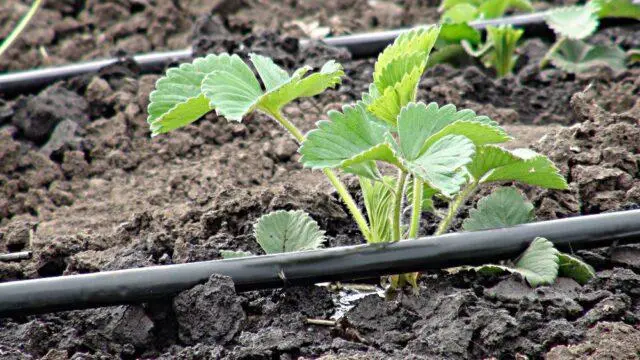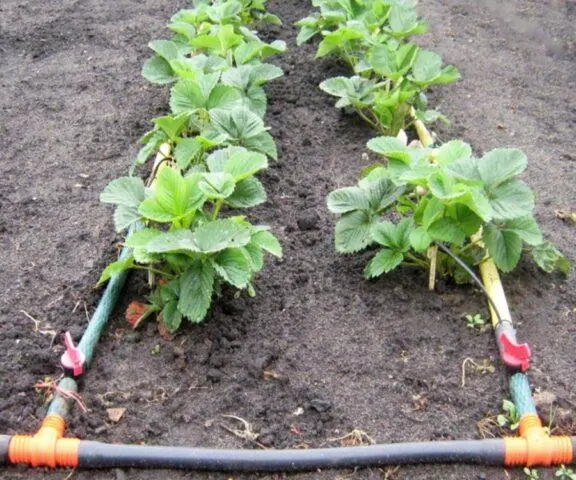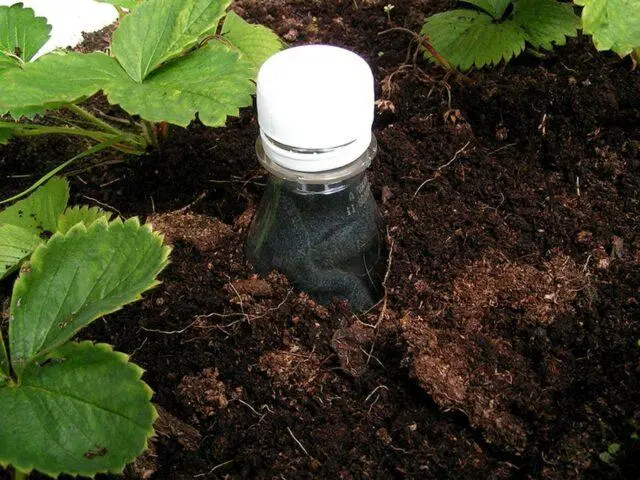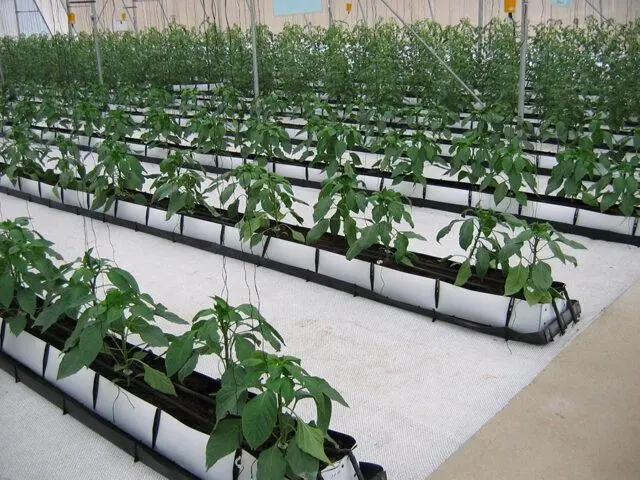Contents
- Drip irrigation device for strawberries
- Strawberry planting scheme for drip irrigation
- What tools and materials will be required to manufacture the system
- How to make a strawberry watering system with drip tape
- How to make drip irrigation for strawberries from plastic bottles with your own hands
- Water consumption and the rate of irrigation of strawberries with drip irrigation
- Recommendations
- Advantages and disadvantages of using the system
- Conclusion
Drip irrigation for strawberries allows you to maintain optimal humidity in the beds with berry crops. To properly organize the system, you need to study its principle of operation and advantages.
Drip irrigation device for strawberries
Photos of drip irrigation for strawberries show that systems can vary in design. But the classic version of the design consists of several parts:
- water pumping unit;
- filtering equipment;
- main pipeline;
- branch pipes and drip tapes.
In some cases, the structure is also equipped with a fertigation device, which allows liquid fertilizers to be applied to the soil simultaneously with irrigation.

The most popular are tubular and tape drip systems.
Operating principle
The principle of operation of drip irrigation is very simple. Water from the main tank flows into tubes or belts evenly distributed throughout the strawberry beds. Through numerous small holes, moisture passes into the soil in small quantities, literally drop by drop.
When using the irrigation method, the soil does not dry out, but it does not become swampy either. Strawberry roots fully assimilate the incoming moisture, the culture develops quickly and brings good yields.
Strawberry planting scheme for drip irrigation
Drip irrigation for strawberries is usually organized when planting crops on agrofiber. Non-woven dark material in the beds keeps the ripening berries clean and also prevents the growth of weeds. But it becomes inconvenient to carry out regular watering, so the drip design is the best solution.
Planting strawberries is carried out according to the following scheme:
- The selected area is dug up and 3-4 buckets of humus or compost are added for every 1 m2 soil. After that, the beds are prepared – their width is determined in accordance with the width of the agrofibre.
- The nonwoven fabric is gently laid over the soil with the absorbent side up. Along the edges of the beds, the agrofibre is pressed with bricks or staples so that it does not stray.
- Places for slots are marked on the surface of the nonwoven material. The distance between them depends on the variety of strawberries – for sprawling large bushes leave 50 cm of free space, for small and medium 30-40 cm.
- In the marked places, cross-shaped cuts are made 5-7 cm wide and the corners are bent inward.
- Strawberry seedlings are placed in prepared holes, making sure that the roots of the culture do not crumple.
In the middle lane and northern regions, it is recommended to place the drip irrigation system on top of the agrofiber when planting. In this case, with the onset of cold weather, it will be easier to dismantle and store it. In the south, you can lay tapes or tubes from below the non-woven material. They are mounted immediately after the preparation of the beds, and only then they are laid on top of the agrofibre.

It is necessary to have a drip irrigation system in the garden as close as possible to the bushes with strawberries.
What tools and materials will be required to manufacture the system
You can organize drip irrigation of strawberries in the open field with your own hands. To do this, you need to prepare simple materials:
- water tank of 200 liters or more;
- plastic pipes with a diameter of 32 mm or more for arranging the highway;
- couplings for connecting pipes to a water tank;
- drip tape with a diameter of 20 mm and a wall thickness of 2 mm;
- connectors – best with a tap, to stop the supply of water to a separate bed;
- plug for the free end of the main pipe;
- corners and fittings;
- washers and rubber seals;
- filter for water purification from mechanical particles.
Videos about drip irrigation of strawberries under agrofibre demonstrate that instead of a special tape, you can use a regular rubber flexible hose of a suitable diameter and thickness.
To equip the system, you will also need to prepare some tools. Namely:
- a hacksaw with frequent fine teeth for cutting main pipes;
- a sharp knife to separate the drip tape or hose;
- drill for making holes for connectors;
- adjustable wrench.
It is also desirable to prepare tow for work in order to reliably seal the joints from leaks.
How to make a strawberry watering system with drip tape
According to the classical scheme, drip irrigation of strawberries under the film is organized using a special tape. The first step is to plan the site – this will allow you to calculate how much materials and components will be needed.
The algorithm for arranging drip irrigation is as follows:
- A water tank is installed near the beds in a convenient place. To ensure good pressure, the tank must be raised at least 2 m above ground level.
- A hole is made in the wall of the container with a small indent from the bottom and a crane is installed. A section of the main pipe is attached perpendicular to it.
- The main line is laid along the beds and places are marked on it for future connections with connectors. If necessary, the pipe is fixed in several places for reliable fixation, a plug is placed on the free end.
- Holes are drilled in the line and their edges are carefully cleaned, then rubber seals are mounted and connectors are installed.
- A drip tape is connected to the system, placing it with irrigation holes up. The end is tucked and wrapped with electrical tape so that water does not leak. If necessary, the tape is also fixed on the bed with wire staples; it cannot be pinched.
The finished system is connected to a tank of water. Drip irrigation for strawberries is carried out three times a week in hot weather for 25-45 minutes.

At the first start, the drip system must be turned on for 6-12 hours for high-quality moistening of the beds
How to make drip irrigation for strawberries from plastic bottles with your own hands
The construction of an irrigation system from drip tapes requires a certain amount of money and effort. If the beds with strawberries are small, then you can install a simpler and more budgetary design from plastic bottles.
The system construction algorithm looks like this:
- Several plastic bottles of 1,5-5 liters are washed and dried.
- Several holes are made near the bottom with a diameter of about 0,4 mm. You can use a hot needle that will quickly and accurately pierce the plastic.
- Warm, settled water for irrigation or a solution of mineral fertilizers is poured into the bottles.
- The containers are placed between two strawberry bushes in such a way that water from holes located on opposite walls flows to both plants.
- Holes are pierced in traffic jams for air flow.
The advantage of drip irrigation from plastic bottles is the simplicity of design. The main disadvantage is that the moisture supply to the strawberry roots cannot be regulated. Water will flow out of the container little by little, but constantly.

5 l snails with drip irrigation of strawberries are enough for an average of 3-5 days
Another way to install drip irrigation on strawberries suggests making a more perfect system based on a plastic canister. The scheme is as follows:
- A small hole is made in the wall of the bottle and a cocktail straw or a ballpoint pen is inserted into it.
- The tube is fixed with a sealant.
- The free end of the rod is sealed with a lighter, and then a hole is pierced in it with a needle to release moisture.
- Set the bottle between the strawberry bushes and direct the tube directly under the root of the plant.
Before using for watering, the straw or rod from the handle must be thoroughly rinsed.

Instead of tubes for a drip system from a bottle, small diameter bundles or hoses can be used.
Water consumption and the rate of irrigation of strawberries with drip irrigation
A professional drip irrigation system, created using special tapes, does not imply continuous wetting of the beds. It is necessary to turn on the structure from time to time, and the frequency depends on the weather and on the stage of vegetation:
- Immediately after planting, strawberries should be watered three times a day for two weeks. Each bush should take at least 500 ml of water.
- After engraftment of seedlings, the interval is increased and drip irrigation is turned on only once every 2-3 days, spending 3 liters of liquid per 1 m2.
- During the fruiting of strawberries, you need to turn on the structure more often. The specific frequency of irrigation, their duration and water consumption are determined individually. In the southern regions, the soil under plants dries up faster than in the north and the Far East.
In general, rare but more abundant drip irrigation is considered more beneficial than constant poor soil moisture.
Recommendations
When using drip irrigation, it is necessary to follow certain rules that simplify the maintenance of the system:
- As the main tank, it is recommended to choose not metal, but plastic containers. The reason is that iron barrels rust quickly. As a result, the chemical composition of the water changes, in addition, the resulting sediment can clog the main filters.
- It is allowed to fill in the tank for drip irrigation not only ordinary liquid, but also solutions of mineral fertilizers. At the same time, they need to be stirred very well, otherwise the main part of the top dressing will simply settle at the bottom of the container.
- With the onset of autumn, before the cold weather, the drip system is dismantled and put away for storage. It must first be cleaned and dried, and thoroughly rinsed again in the spring before a new installation.
Drip irrigation of strawberries in a greenhouse is no less popular than in the open field. Installation schemes and algorithms, as well as the rules of use, are exactly the same. Only water consumption rates can differ, they are determined in accordance with the actual rate of drying of the soil.

In the greenhouse, drip irrigation of strawberries is required less frequently than in the garden
Advantages and disadvantages of using the system
Watering strawberries with a drip method has its pros and cons. The benefits include:
- saving water – the liquid is consumed about half as much as when using other methods;
- the possibility of dosing irrigation – depending on the situation, you can reduce or increase the flow of moisture to the bushes;
- autonomy – the drip method does not require constant monitoring, strawberries can receive water even in the absence of a gardener;
- the possibility of applying liquid fertilizers – top dressing is easy to combine with watering without any hassle;
- the convenience of moistening strawberries during dense planting – when using the method, water does not fall on the leaves of the bushes.
Drip irrigation is convenient because it helps prevent the development of fungi. The latter often occur in too damp soil, and when using the irrigation method, even in a greenhouse, the soil remains moderately wet.
As for the cons of drip irrigation, they include several points:
- the construction of a structure requires time, effort and certain monetary costs;
- blockages can occur in the line and feed tubes, reducing the effectiveness of humidification and causing wilting of strawberries.
With drip irrigation, the roots of a berry crop grow very quickly and abundantly. Sometimes this leads to the fact that the bushes are intertwined with each other and begin to interfere with the development of each other.
Conclusion
Drip irrigation for strawberries can be used in a closed greenhouse or garden. The system is easy to do with your own hands, it is usually more convenient to use it than to moisten the plantings in the classical way.









